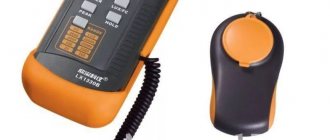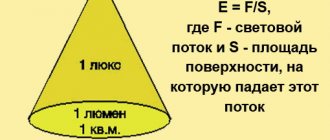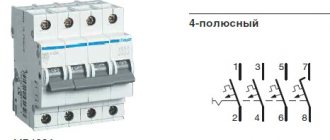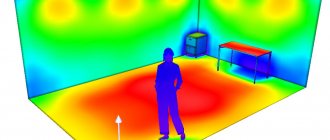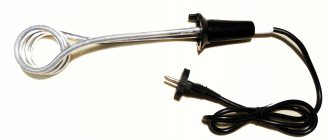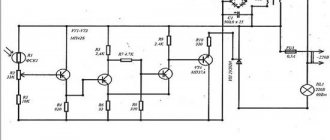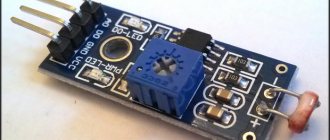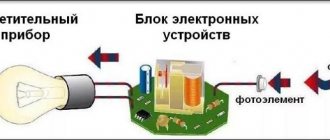Types of lux meters
Various devices for measuring illumination differ in purpose and type of design:
Various devices for measuring illumination differ in purpose and type of design:
- Block with remote sensor.
Using a wire, the sensor is connected to the main part of the device. This allows you to take the necessary measurements in hard-to-reach areas. This model is used when it is necessary to measure the degree of illumination in several directions; - Monoblock.
In these models, the sensor and the working unit are installed in one housing. There are options with a removable sensor. These are small, portable devices, but they are not designed to work in hard-to-reach areas.
Based on the type of built-in indicator, lux meters are divided into two types:
- Analog.
The indicator is a scale graduated in lux. The data is recorded based on the arrow readings. The measurement accuracy of such devices is not the highest; - Digital.
Professional models of meters have digital displays. The data is displayed in numbers, so the instruments are more accurate.
Simple light measurements are carried out using inexpensive instruments. If you need to determine the average value of the illumination level and determine the uneven distribution of the light flux, it is better to use expensive equipment with additional functions. Such devices independently make the necessary calculations. The built-in memory saves the received parameters, then they are transferred to the computer.
The set of professional devices includes several filters. If it is necessary to work in high light conditions, absorbing filters are used.
Improved multifunctional models with expanded equipment allow you to significantly increase the measurement interval.
Characteristics of testo 540 and 545
Among the many measuring devices, you should pay attention to the German-made “testo 540” digital lux meter model. Thanks to its qualities and technical characteristics, this device for measuring illumination has won the recognition of many Russian users.
It is made in the form of a monoblock design with a photocell integrated directly into the body. The absence of a connecting wire makes it more convenient to use, since one hand is enough to take measurements.
The configuration and dimensions of the lux meter are comparable to a mobile phone. All readings are displayed on the liquid crystal display, and the entire keyboard consists of three buttons.
- The first button is used to turn it on and off;
- The second is for selecting the system and units of measurement;
- The third is for saving the results obtained.
Illumination measurements can be performed in the range from 0 to 100 thousand lux. The device is very easy to use and can be used in almost any area of daily life.
A professional meter is considered a more advanced device - the testo 545 lux meter, in which the light receiver and the electronic unit are located separately, connected by a conductor. It has a significantly larger number of functions and allows the use of different measurement methods. Up to 99 measurement locations and up to 3000 results obtained can be stored in memory. When connected to a computer, it becomes possible to create a three-dimensional illumination graph for a single room, and print the received information on a printer.
Application area
Different types of lux meters are used in the following areas and institutions:
- Occupational Safety and Health Service and Chief Power Engineer;
- Educational institutions;
- Assessment of workplaces;
- Transport companies;
- Sanitary and epidemiological surveillance;
- Health care system;
- Centers for scientific research, standardization and metrology;
- Agricultural facilities;
- Museums, archives (for the preservation of documents, exhibits, books).
A lux meter measures the degree of light intensity in indoor and outdoor spaces. Taking into account operating conditions and research goals, specialists use different types of devices.
Mechanism of operation
The operating principle of a lux meter is based on transforming the flow of light energy into electric current. The measurement takes place in several stages:
- A sensitive photocell reacts to the light flux incident on its surface;
- Electrons are activated;
- Energy is converted from light to electricity, and the intensity of the radiation determines the strength of the current;
- The microprocessor records the current parameters;
- Data in lux is shown on the display.
A specialist who works with a lux meter must take into account the features of the equipment in order to obtain the most accurate research results.
To determine lighting parameters in rooms with powerful luminous fluxes, in addition to the main meter, diffusing or absorbing nozzles are used. Each type of lamp has its own light spectrum.
All devices for measuring illumination undergo certification, after which metrological certificates are issued for them.
Test conditions
The test took place in a room without sources of daylight or artificial lighting. We placed light sources on a horizontal surface. The illumination was alternately set to 100 lux, 500 lux and 1000 lux. The photometric head of our luxmeter was located perpendicular to the axis of the lamp. Then, in the same way, we placed smartphones with installed applications. The front camera and brightness sensor were located in the same place where the photometer was previously located.
This arrangement was suitable for all applications except the paid “Luxmeter Pro Advanced”, since it uses light reflected from the surface to measure illumination. This application also provides settings for the types of light source, distance to it, etc.
Some applications allowed calibration, and if possible, we carried it out in accordance with the manufacturer's instructions, namely at 100 lux.
How to use the device
Before measurement, non-working lighting elements are replaced with new ones, and the lamps are cleaned. Equipment and furniture are removed from the premises. Windows are washed thoroughly.
Prepare a floor plan in advance. In areas where workplaces are located, control points are marked where lamps are installed. Also, according to established standards, emergency lighting is designated.
Important! Lux meters with an error of more than 10% are used if the correction factor is taken into account, which relates to the spectral composition of a particular light source.
Norms and calculation procedure
Lighting requirements depend on the purpose of a particular room and the type of human activity. The standards by which the indicator is measured are established in GOST R 54944-2012, the norms are in SNiP. All parameters apply not only to the floor, but also to the planes of the tables. Tables are available that can be used to determine lux for any property.
When developing a lighting system for a residential building (apartment), you can use the data from this table:
| Standard according to SNiP (LK) | Room |
| 20 | Passages to attics, basements |
| 20 | Electrical switchboards, boiler rooms, ventilation chambers |
| 20 | Stairs |
| 50 | Bathrooms. showers, toilets |
| 50 | Corridors and halls in houses (apartments) |
| 75 | Wardrobe rooms |
| 100 | Saunas, locker rooms, swimming pools |
| 150 | Living rooms and kitchens |
| 150 | GYM's |
| 200 | Children's rooms |
| 300 | Libraries, offices |
The calculation is carried out in 2 stages:
- determining the required level of luminescence;
- determining the number of light bulbs.
Formula for calculating the glow:
N*P*K, where:
N – norm (according to the table);
P – room area;
K – coefficient depending on the height of the ceilings (1 for 2.5-2.7 m, 1.2 for 2.7-3 m, 1.5 for 3-3.5 m, 2 for 3.5-4, 4 m).
To calculate the number of lamps, the result must be divided by the lumens indicated in the technical documentation of the lamps selected for installation.
Attention! In practice, this formula should not be used, since it does not take into account flows directed towards walls and furniture. A more reliable result is obtained if the number of lamps obtained in the calculations is multiplied by 2 (it has been proven that only half of the light flux reaches the floor).
If major repairs or reconstruction work is carried out, the contractor’s employees handle the calculations.
Determination of ripple factor
Ripple factor
is a characteristic that reflects the unevenness of light radiation. During the measurement process, two types of pulsations are distinguished - brightness and illumination. These parameters are expressed as percentages; their permissible values are indicated in the current version of SP 52.13330.2011 “Natural and artificial lighting”.
Pulsation indicators are measured for lighting fixtures and technical devices with displays: smartphones, PCs, tablets. To measure pulsation indicators, the following algorithm is used:
- The luxmeter-pulsemeter is placed on the surface so that the light stream falls on the photosensor;
- the device activates the pulse meter mode by pressing the “P” button;
- record the readings that are displayed on the display.
To measure the ripple factor of monitors, screens, LED sources, you need to perform the following steps:
- position the luxmeter-pulsemeter at the closest possible distance from the object being measured, while ensuring that the sensitive photosensor is facing this object;
- if the meter is multifunctional, you need to turn it into heart rate monitor mode (button “P”);
- capture data from the display.
The accuracy of the indicators recorded during the measurement process depends on several factors:
- presence of extraneous light sources;
- manipulations with the pulse meter (the device must lie motionless during measurements);
- other interference (any movement of people, birds, animals, objects in the immediate vicinity of the measurement site).
Important! Accurate indicators for measuring the pulsation of fluorescent, gas-discharge lamps, and LEDs are obtained only if a five-minute interval is maintained, after which these lighting elements begin to operate in a stable mode. Otherwise the data will be incorrect.
According to SanPiN 2.2.1/2.1.1.1278-03, in bathrooms, workshops and waiting rooms the maximum pulsation value is 20%, in offices this figure is 15%, in living and sleeping rooms the maximum pulsation level is 10%, in children's rooms, offices, libraries, as well as workplaces with PCs – 5%.
It is important to understand that a person does not always notice the flickering of lamps, but exceeding the permissible value of the pulsation coefficient negatively affects mood, the nervous system, and labor productivity.
results
During our testing, we found that while it was possible to calibrate to a certain value in some applications, it was difficult to accurately determine it. Thus, either the step was large, or the value of 100 lux was not set at all (for example, the maximum value that could be set on the iPhone 5 with LightMeter by whitegoods was 34 lux). Often the deviations from the control values turned out to be very high (up to 113% for the Samsung Galaxy S5 with the “Lux Light Meter” application from Geogreenapps). When using the 500 lux reference, the smartphone display showed 1.063 lux. The lowest deviation of 3% was on the iPhone 5 with "LightMeter by whitegoods". At 500 lux, this smartphone showed 484 lux. At the same time, we cannot claim that this particular combination will always lead to the smallest possible deviations. When using a value of 100 lux and the same application, the deviation reached 89%, and the device showed 11 lux.
We also noticed that the displayed values on devices from Sony, Samsung and Nokia were significantly higher than the reference values, while on the iPhone they were significantly lower. The average deviation in all applications on Android smartphones and on Windows Phones was approximately 60% higher than the control ones. The discrepancy between the values measured by different iPhones was 60% lower than the reference values.
We also noticed that various applications installed on smartphones from Samsung and Sony showed similar values. Most likely, these devices use a brightness sensor rather than a camera to measure light.
In some Samsung models, you can switch to the engineering menu mode using the combination *#0*#. By selecting the “Light sensor” item, you can find out the expected illumination without installing the application. So in this case, a special program may not be needed. However, the performance on these devices also deviated from the reference value within the range of 37%-113%.
Light level detection
Illumination
- a quantity that is expressed in relation to the luminous flux falling per unit area. This indicator is measured in Lx (lm/m2) and does not depend on the direction. A lux meter measures illuminance to check conditions in work and living spaces. Based on the data obtained, it is possible to create comfortable conditions for people, plants, animals, and also determine the performance of devices. You can measure illumination using the following algorithm:
- The lux meter is placed at the desired point and installed horizontally so that the photosensor faces the light sources;
- Record the data that is displayed on the display.
A lux meter shows the amount of light that reaches a surface from all available sources. If you need to determine the characteristics of one lighting fixture, the others should be turned off while the lux meter is running.
According to SanPin 2.2.1/2.1.1.1278-03, the illumination of tables for classes and creativity, school desks, and rooms for engineers must be at least 500 Lux. On computer desks, in library rooms and rooms for classes with preschoolers, the minimum illumination level is 400 Lux. In workrooms and workshops, the minimum value of this parameter is 300 Lux.
An insufficient level of illumination increases the risk of developing pathologies of the visual organs, contributes to rapid fatigue, and decreased ability to work.
Lighting in educational institutions requires special attention. If students read, write, or work on computers in low light, their eyes experience serious strain.
Purpose and principle of operation of a lux meter
The main purpose of the device is to measure the level of illumination at the required point in space.
Where a lux meter is used, you can easily adjust this indicator, which depends on:
- number of light sources, including artificial and natural;
- light pressure of each source;
- distance between the measurement point and the light source;
- reflectivity of nearby surfaces.
The device is actively used in the following cases:
- To control sanitary standards for lighting in residential premises.
- To measure the level of illumination of workplaces, which allows maintaining comfortable working conditions and hygiene for workers.
- To control the illumination of premises in production areas, schools, libraries, medical institutions, museums, etc.
- For selecting the brightness of lamps in greenhouses and greenhouse farms where plants are bred and maintained.
- To determine the shooting exposure when taking photographs.
- To adjust the brightness of signal lights and illuminated advertising.
- As part of a pulse meter-brightness meter - to measure the degree of pulsation of the image of monitors and illumination in general, caused by the flickering of LEDs, fluorescent and energy-saving lamps.
- To check whether the actual illumination corresponds to the calculated level when installing lighting systems.
When the device operates, a luminous flux of a certain spectrum is converted into an electric current with the corresponding intensity characteristics of the first.
The results are displayed on the device screen.
Given how a lux meter works, it makes sense to use models that allow you to select the operating mode for a specific light spectrum.
Operating principle of the device:
• The electrons in a photocell made from a semiconductor are activated by light. The brighter the light flux, the more actively electrons are released.
• The throughput of the photocell changes, which is recorded by the electronics of the device, which, after processing by the processor, is displayed on the screen.
• The illumination meter in operation produces results, the correctness of which depends on the correct orientation of the sensor relative to the light flux.
Criterias of choice
To choose the optimal photometer model, consider the following parameters:
- Functionality;
- Type of device (professional, household);
- Range of measured illumination indicators;
- Measurement accuracy level and error;
- Size of the device (it is more convenient to work if the meter fits in one hand);
- PC compatible;
- Display size and backlighting;
- Cost of the device;
- Availability of verification.
If a lux meter is needed for quick measurements, an inexpensive monoblock with a small set of functions is suitable. For professional work, you need a multifunctional device with built-in memory, a removable sensor, minimal error and verification.
If the lighting level complies with current standards, work and study will be more comfortable. However, not all organizations comply with the established rules. As a result, people experience vision problems and decreased performance. A lux meter helps prevent this.
Based on the data obtained as a result of measurements, new light sources are installed or existing lamps are correctly positioned. The criteria discussed in the article will help you choose the right light meter.


